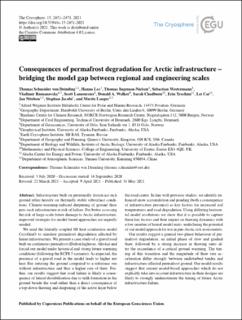| dc.contributor.author | Schneider Von Deimling, Thomas | |
| dc.contributor.author | Lee, Hanna | |
| dc.contributor.author | Ingeman-Nielsen, Thomas | |
| dc.contributor.author | Westermann, Sebastian | |
| dc.contributor.author | Romanovsky, Vladimir | |
| dc.contributor.author | Lamoureux, Scott | |
| dc.contributor.author | Walker, Donald A. | |
| dc.contributor.author | Chadburn, Sarah E. | |
| dc.contributor.author | Trochim, Erin | |
| dc.contributor.author | Cai, Lei | |
| dc.contributor.author | Nitzbon, Jan | |
| dc.contributor.author | Jacobi, Stephan | |
| dc.contributor.author | Langer, Moritz | |
| dc.date.accessioned | 2022-02-16T11:25:25Z | |
| dc.date.available | 2022-02-16T11:25:25Z | |
| dc.date.created | 2022-02-11T11:27:28Z | |
| dc.date.issued | 2021 | |
| dc.identifier.citation | The Cryosphere. 2021, 15 (5), 2451-2471. | en_US |
| dc.identifier.issn | 1994-0416 | |
| dc.identifier.uri | https://hdl.handle.net/11250/2979326 | |
| dc.description.abstract | Infrastructure built on perennially frozen ice-rich ground relies heavily on thermally stable subsurface conditions. Climate-warming-induced deepening of ground thaw puts such infrastructure at risk of failure. For better assessing the risk of large-scale future damage to Arctic infrastructure, improved strategies for model-based approaches are urgently needed.
We used the laterally coupled 1D heat conduction model CryoGrid3 to simulate permafrost degradation affected by linear infrastructure. We present a case study of a gravel road built on continuous permafrost (Dalton highway, Alaska) and forced our model under historical and strong future warming conditions (following the RCP8.5 scenario). As expected, the presence of a gravel road in the model leads to higher net heat flux entering the ground compared to a reference run without infrastructure and thus a higher rate of thaw. Further, our results suggest that road failure is likely a consequence of lateral destabilisation due to talik formation in the ground beside the road rather than a direct consequence of a top-down thawing and deepening of the active layer below the road centre. In line with previous studies, we identify enhanced snow accumulation and ponding (both a consequence of infrastructure presence) as key factors for increased soil temperatures and road degradation. Using differing horizontal model resolutions we show that it is possible to capture these key factors and their impact on thawing dynamics with a low number of lateral model units, underlining the potential of our model approach for use in pan-Arctic risk assessments.
Our results suggest a general two-phase behaviour of permafrost degradation: an initial phase of slow and gradual thaw, followed by a strong increase in thawing rates after the exceedance of a critical ground warming. The timing of this transition and the magnitude of thaw rate acceleration differ strongly between undisturbed tundra and infrastructure-affected permafrost ground. Our model results suggest that current model-based approaches which do not explicitly take into account infrastructure in their designs are likely to strongly underestimate the timing of future Arctic infrastructure failure.
By using a laterally coupled 1D model to simulate linear infrastructure, we infer results in line with outcomes from more complex 2D and 3D models, but our model's computational efficiency allows us to account for long-term climate change impacts on infrastructure from permafrost degradation. Our model simulations underline that it is crucial to consider climate warming when planning and constructing infrastructure on permafrost as a transition from a stable to a highly unstable state can well occur within the service lifetime (about 30 years) of such a construction. Such a transition can even be triggered in the coming decade by climate change for infrastructure built on high northern latitude continuous permafrost that displays cold and relatively stable conditions today. | en_US |
| dc.language.iso | eng | en_US |
| dc.rights | Navngivelse 4.0 Internasjonal | * |
| dc.rights.uri | http://creativecommons.org/licenses/by/4.0/deed.no | * |
| dc.title | Consequences of permafrost degradation for Arctic infrastructure - Bridging the model gap between regional and engineering scales | en_US |
| dc.type | Journal article | en_US |
| dc.type | Peer reviewed | en_US |
| dc.rights.holder | © Author(s) 2021 | en_US |
| dc.description.version | publishedVersion | en_US |
| cristin.ispublished | true | |
| cristin.fulltext | original | |
| cristin.qualitycode | 2 | |
| dc.identifier.doi | 10.5194/tc-15-2451-2021 | |
| dc.identifier.cristin | 2000390 | |
| dc.source.journal | The Cryosphere | en_US |
| dc.source.volume | 15 | en_US |
| dc.source.issue | 5 | en_US |
| dc.source.pagenumber | 2451-2471 | en_US |

